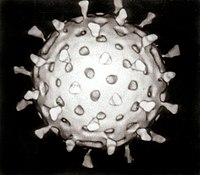
Photo from wikipedia
BACKGROUND Metagenomic next generation sequencing (mNGS) is becoming increasingly available for pathogen detection directly from clinical specimens. These tests use target-independent, shotgun sequencing to detect potentially unlimited organisms. The promise… Click to show full abstract
BACKGROUND Metagenomic next generation sequencing (mNGS) is becoming increasingly available for pathogen detection directly from clinical specimens. These tests use target-independent, shotgun sequencing to detect potentially unlimited organisms. The promise of this methodology to aid infection diagnosis is demonstrated through early case reports and clinical studies. However, the optimal role of mNGS in clinical microbiology remains uncertain. CONTENT We reviewed studies reporting clinical use of mNGS for pathogen detection from various specimen types, including cerebrospinal fluid, plasma, lower respiratory specimens, and others. Published clinical study data were critically evaluated and summarized to identify promising clinical indications for mNGS-based testing, to assess the clinical impact of mNGS for each indication, and to recognize test limitations. Based on these clinical studies, early testing recommendations are made to guide clinical utilization of mNGS for pathogen detection. Finally, current barriers to routine clinical laboratory implementation of mNGS tests are highlighted. SUMMARY The promise of direct-from-specimen mNGS to enable challenging infection diagnoses has been demonstrated through early clinical studies of patients with meningitis or encephalitis, invasive fungal infections, community acquired pneumonia, and other clinical indications. However, the proportion of patient cases with positive clinical impact due to mNGS testing is low in published studies and the cost of testing is high, emphasizing the importance of improving our understanding of 'when to test' and for which patients mNGS testing is appropriate.
Journal Title: Clinical chemistry
Year Published: 2020
Link to full text (if available)
Share on Social Media: Sign Up to like & get
recommendations!